Numismatic Treasures #5: 1781 Libertas Americana Medal
 LeeG
Posts: 12,162 ✭
LeeG
Posts: 12,162 ✭
82 or 1783.  Read all about this and other information about the Libertas Americana Medal in the Sept 2008 Penny-Wise article written by Ray Rouse. It's a must read!!!
Read all about this and other information about the Libertas Americana Medal in the Sept 2008 Penny-Wise article written by Ray Rouse. It's a must read!!!  I hope you enjoy your journey:
I hope you enjoy your journey:
The Libertas Americana medal is most famously associated with Benjamin Franklin, as the designs and legends were the result of his collaboration with other top minds of his era: Robert Livingston, who offered early encouragement; Sir William Jones, the Englishman who suggested a line from Horace be used as the reverse legend; fresco painter E.A. Gibelin, who was the first to sketch Franklin's conception. Of course, it was Franklin's friendship with the top French sculptor of the period, Augustin Dupre, that made the Libertas Americana medal an exceptionally beautiful monument to the American Liberty they both held in great esteem. Guided by Franklin's influence, it was Dupre who conceived the beautiful face of Liberty with flowing tresses that came to be the instantly identifiable face of the new nation.
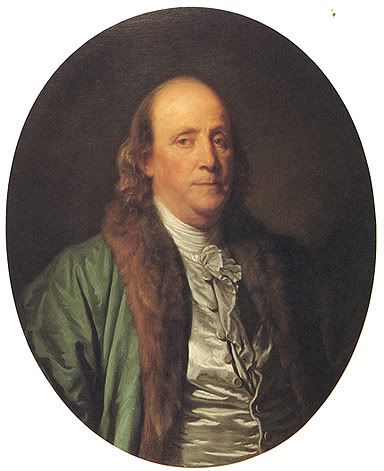
1777 Jean-Baptiste Greuze portrait of Franklin
Franklin was very pleased with his creation. He found that Sir William Jones' suggestion for a reverse legend, translated as "The courageous child was aided by the Gods," was perfectly applicable. It was probably Franklin's idea to show the lion, representing Great Britain, with its tail between its legs. When he wrote to Robert Livingston, who served with Franklin on the committee to create the Declaration of Independence, on April 15, 1783, he reported general satisfaction with the design: "it is mightily well received, and gives general pleasure." He also included a specimen in silver for "the President of Congress" and mentioned that he presented "one in silver to each of the French ministers, as a monumental acknowledgement, which may go down in future ages, of the obligations we are under to this nation." When this letter was written, the President of Congress and the recipient of a silver medal precisely like the one offered here was none other than Elias Boudinot of New Jersey, the man who would become Director of the Mint in 1795. As noted above, Washington also received a silver specimen, Jefferson displayed a specimen at his home (composition unknown), and undoubtedly many men of similar stature in both Europe and America likewise were given specimens in silver. Washington's was included in a set of Comitia Americana medals, and Jefferson may have intended to include Libertas Americana medals in the sets that Congress "directed me to present ... to the different powers of Europe, to the universities of Europe, to certain officers there ..." .
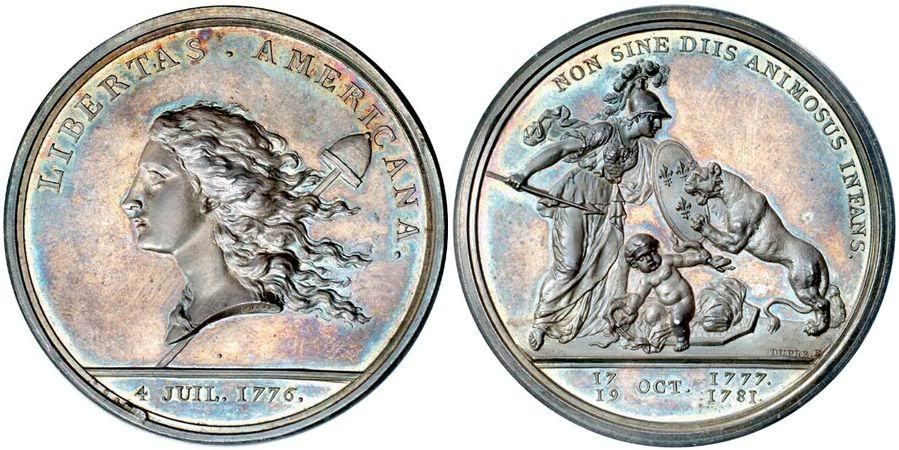
1782 Libertas Americana Medal, Betts-615, Silver in PCGS MS-65, Diameter: 47.8 mm. Weight: 783.7 grains. Thickness at edge: 3.6 mm. From the Cardinal Collection sold by ANR for $115,000 on 06/30/05. This example, once the property of famed numismatist Harry Bass, was prominently featured in both Part I of the presentation of the Bass collection and Dave Bowers' book More Adventures with Rare Coins. From New Netherlands Coin Company's 63rd sale, April 1972, Lot 615; Bowers and Merena's sale of the Harry W. Bass, Jr. Collection, Part I, May 1999, Lot 2084.
The portrait of Liberty, with her free-flowing curls and a Liberty cap atop a pole behind her shoulder, had an obvious influence on the half cents of 1793 to 1797, and the cents of 1793 to 1796. The reverse of the medal depicts the infant America, protected by an Amazon-like France from the aggressive British lion. America is strangling two snakes, which represent the battles of Yorktown and Saratoga, important American victories whose dates appear on the exergue. Diagnostic obverse die lumps near 3 and 7 o'clock are characteristic of this scarce and coveted medal. A fully struck and satiny chocolate-brown piece with a solitary faded mark noted near the bust tip.
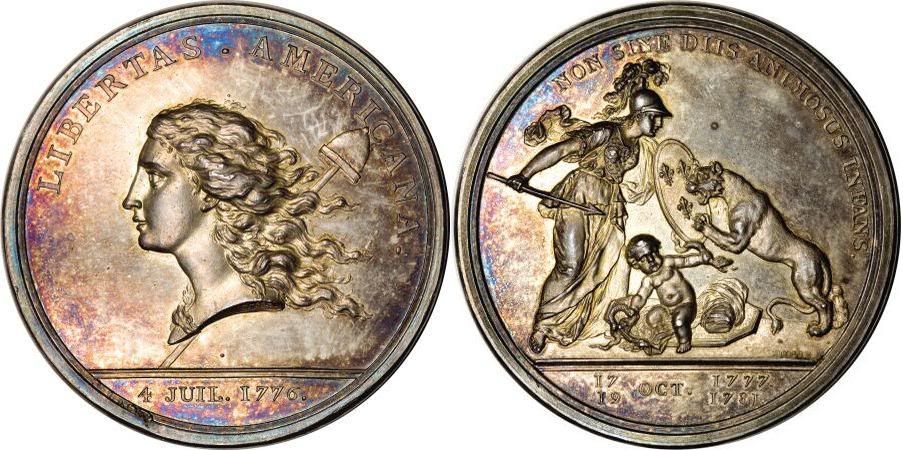
1781 Libertas Americana Medal MS64 PCGS, Silver, Betts-615, 47.5 mm, 57.22 gm. $149,500 on 08/08/07.
Benjamin Franklin, January 17, 1706 – April 17, 1790, was one of the Founding Fathers of the United States of America. A noted polymath, Franklin was a leading author and printer, satirist, political theorist, politician, scientist, inventor, civic activist, statesman and diplomat. As a scientist he was a major figure in the Enlightenment and the history of physics for his discoveries and theories regarding electricity. He invented the lightning rod, bifocals, the Franklin stove, a carriage odometer, and a musical instrument. He formed both the first public lending library in America and first fire department in Pennsylvania. He was an early proponent of colonial unity and as a political writer and activist he, more than anyone, invented the idea of an American nation and as a diplomat during the American Revolution, he secured the French alliance that helped to make independence possible.
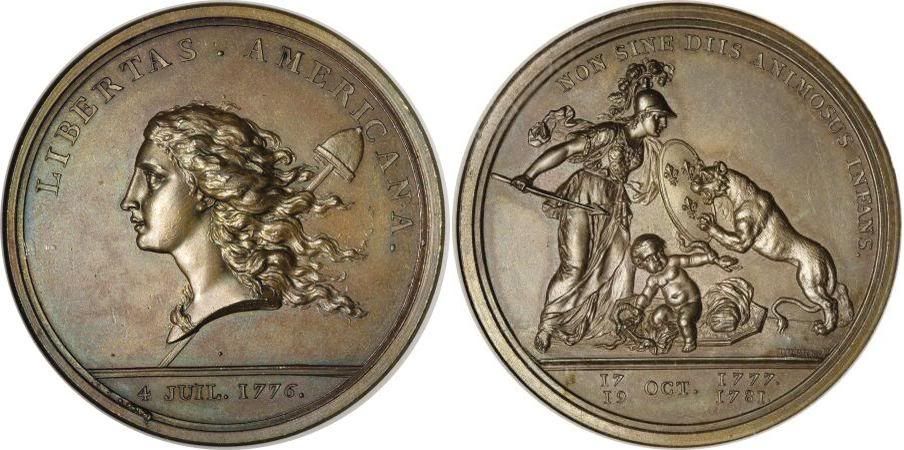
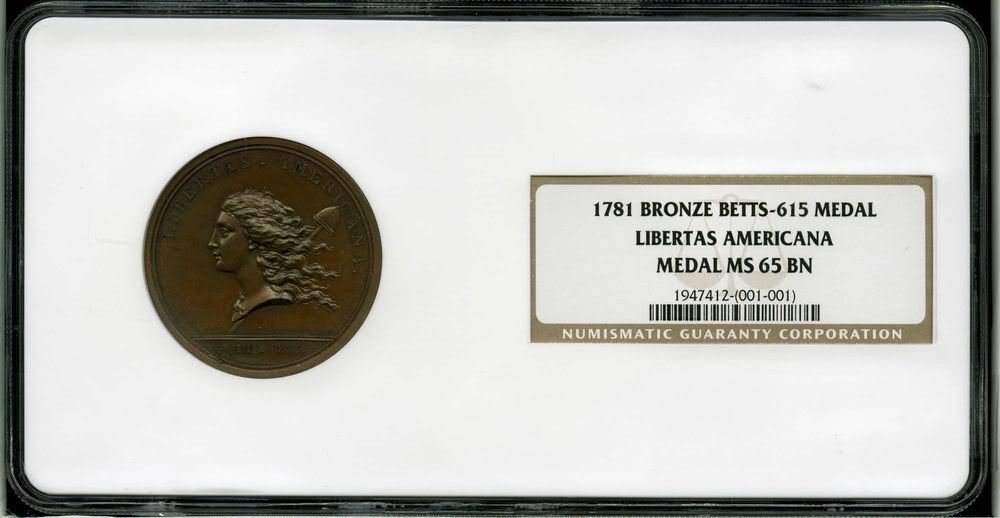
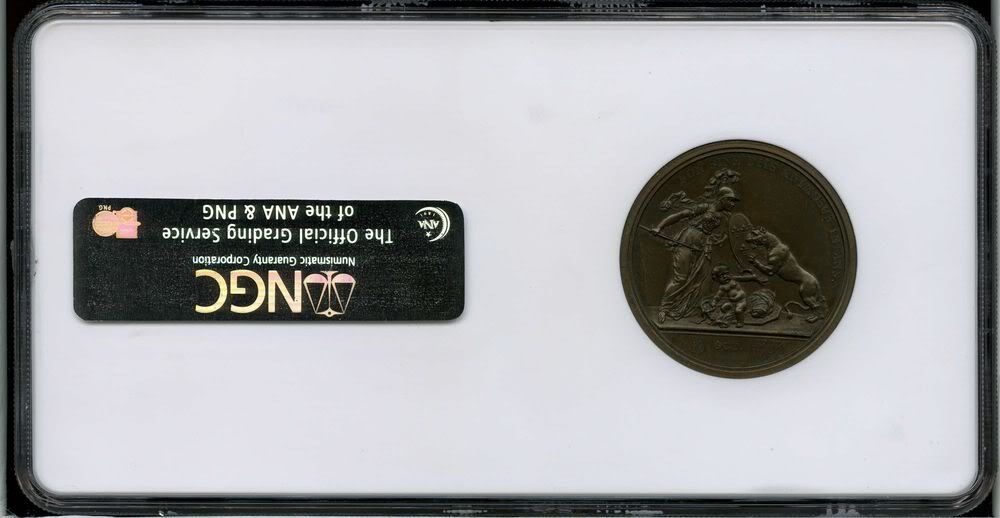
Sold for $48,875 on 05/09/07
 I hope you enjoy your journey:
I hope you enjoy your journey:The Libertas Americana medal is most famously associated with Benjamin Franklin, as the designs and legends were the result of his collaboration with other top minds of his era: Robert Livingston, who offered early encouragement; Sir William Jones, the Englishman who suggested a line from Horace be used as the reverse legend; fresco painter E.A. Gibelin, who was the first to sketch Franklin's conception. Of course, it was Franklin's friendship with the top French sculptor of the period, Augustin Dupre, that made the Libertas Americana medal an exceptionally beautiful monument to the American Liberty they both held in great esteem. Guided by Franklin's influence, it was Dupre who conceived the beautiful face of Liberty with flowing tresses that came to be the instantly identifiable face of the new nation.

1777 Jean-Baptiste Greuze portrait of Franklin
Franklin was very pleased with his creation. He found that Sir William Jones' suggestion for a reverse legend, translated as "The courageous child was aided by the Gods," was perfectly applicable. It was probably Franklin's idea to show the lion, representing Great Britain, with its tail between its legs. When he wrote to Robert Livingston, who served with Franklin on the committee to create the Declaration of Independence, on April 15, 1783, he reported general satisfaction with the design: "it is mightily well received, and gives general pleasure." He also included a specimen in silver for "the President of Congress" and mentioned that he presented "one in silver to each of the French ministers, as a monumental acknowledgement, which may go down in future ages, of the obligations we are under to this nation." When this letter was written, the President of Congress and the recipient of a silver medal precisely like the one offered here was none other than Elias Boudinot of New Jersey, the man who would become Director of the Mint in 1795. As noted above, Washington also received a silver specimen, Jefferson displayed a specimen at his home (composition unknown), and undoubtedly many men of similar stature in both Europe and America likewise were given specimens in silver. Washington's was included in a set of Comitia Americana medals, and Jefferson may have intended to include Libertas Americana medals in the sets that Congress "directed me to present ... to the different powers of Europe, to the universities of Europe, to certain officers there ..." .

1782 Libertas Americana Medal, Betts-615, Silver in PCGS MS-65, Diameter: 47.8 mm. Weight: 783.7 grains. Thickness at edge: 3.6 mm. From the Cardinal Collection sold by ANR for $115,000 on 06/30/05. This example, once the property of famed numismatist Harry Bass, was prominently featured in both Part I of the presentation of the Bass collection and Dave Bowers' book More Adventures with Rare Coins. From New Netherlands Coin Company's 63rd sale, April 1972, Lot 615; Bowers and Merena's sale of the Harry W. Bass, Jr. Collection, Part I, May 1999, Lot 2084.
The portrait of Liberty, with her free-flowing curls and a Liberty cap atop a pole behind her shoulder, had an obvious influence on the half cents of 1793 to 1797, and the cents of 1793 to 1796. The reverse of the medal depicts the infant America, protected by an Amazon-like France from the aggressive British lion. America is strangling two snakes, which represent the battles of Yorktown and Saratoga, important American victories whose dates appear on the exergue. Diagnostic obverse die lumps near 3 and 7 o'clock are characteristic of this scarce and coveted medal. A fully struck and satiny chocolate-brown piece with a solitary faded mark noted near the bust tip.

1781 Libertas Americana Medal MS64 PCGS, Silver, Betts-615, 47.5 mm, 57.22 gm. $149,500 on 08/08/07.
Benjamin Franklin, January 17, 1706 – April 17, 1790, was one of the Founding Fathers of the United States of America. A noted polymath, Franklin was a leading author and printer, satirist, political theorist, politician, scientist, inventor, civic activist, statesman and diplomat. As a scientist he was a major figure in the Enlightenment and the history of physics for his discoveries and theories regarding electricity. He invented the lightning rod, bifocals, the Franklin stove, a carriage odometer, and a musical instrument. He formed both the first public lending library in America and first fire department in Pennsylvania. He was an early proponent of colonial unity and as a political writer and activist he, more than anyone, invented the idea of an American nation and as a diplomat during the American Revolution, he secured the French alliance that helped to make independence possible.



Sold for $48,875 on 05/09/07
1
Comments
Your posts are always well presented. However, in this case, it would be nice if you had not mentioned and paraphrased mis-information from previous writers, without adding the latest information available.
Franklin did not have any contact with Augustine Dupre. There is no record of this ever happening. It's is also extremely doubtful that he had anything to do with creating any part of the designs. He was merely the engraver. I have written extensively about this in an article which appeared recently in the Medal Collector's of America Advisory.
I also wrote a letter to the editor of P-W about Rouse's article, which did not address the latest information either.
By copying from previous works and writings, it is good to pass along knowledge, but at the same time, it is the responsibility of any current writer to keep up with new research and developments.
Please keep up the interesting posts.
Lee, these Numismatic Treasures posts are entertaining and educational. I applaud your efforts!
What will be the topic of #6?
The Libertas Americana is my favorite medal and I am very fortunate to own two of them (both around EF).
If you want to own a very historical and amazing piece of American and Numismatic history, this is it!
Ankur
PCGS Registries
Box of 20
SeaEagleCoins: 11/14/54-4/5/12. Miss you Larry!
From Thomas Brand Hollis (unpublished)
Bruton Street June 21. 1784.
Sir
The loss of a young person of fine dispositions and excellent principles, and in whose education I greatly interested my self, as intending him to be my son and heir, has prevented me attending to matters which at another time would have engaged my thoughts, was it not for this, I should justly incur the imputation of negligence, as it is some time since I received from you a medal to commemorate the glorious events of the Independence of America and the total subjugation of their enemies events which I rejoice at as I have always detested and abhorred the principle of enslaving mankind and depriving them of the rights of human nautre, under any pretence whatsoever.
The medal I esteem on all accounts a great honor from the donor, it is a most valuable addition to my friends collection of Liberty coins as he used to call his
The head of your Liberty would have pleased him. It is simple and noble the execution is good but I could have wished the names and dates of your victories had been wrote in capitals and also the date of your independence that every part might be intelligible.
There is a mistake in the word Juil which might yet be altered.
Indeed Sir, the three noble Subjects united in your medal claim each a distinct medal and had I the honor to be an American it should be done, for never in the Annals of mankind such events have had such glorious consequences. The divine rights of human naute are declared and established against all the Arts of Priests and Tyrants and there is now an Asylum for the injured and oppressed.
I hope the coinage of America will be attended too at proper time. to be decimal on account change as the present roman coin is and the copper currency to perpetuate Historical events as mentioned by Addison in the Spectator which might be done with small expence.
To me it is matter of surprize, after having considered it and which I cannot sufficiently understand how the Romans struck their medals. as it is known they were often struck in the camp and of emperors who lived but three days and perhaps there are not two of the same Dye of any one Emperor. I rejoice you esteem my friends labors for the Publick. There never was a man who having the means indulged less and spent his whole time in publick services. candor to the publick obliged the compilors of the Memoirs not to conceal any sentiment of my late friends his anxiety for the publick weal made him suspicious of Characters eminently great but which by their strenuous exertions have demonstrated to the world how much they are superior to detraction.
The mistake about your letter attributed to Mr. Adams shall be rectified in a future Edition.
The first opportunity I will convey to you Milton’s tractate on education which I could not induce the Booksellers, tho at my expence, to print with Johnson’s poets as it always accompanied his Poeticks. the Cowleys Propositions is published with his Poems—such is the fear of Johnson with the Bookseller who unwillingly sell the remarks on Miltons Life. May you like Timoleon, long enjoy the glorious satisfaction of having emancipated your country and established Freedom on the broad basis of equal Laws. and beleive me to be with the greatest esteem and respect for your worth and excellence Sir Your much obliged humble Servant
T Brand Hollis.
Please provide the contents of the Dupre letter, or a link to it.
If you are referring to the two 1785 letters, they have nothing whatsoever to do with the L A medal, which is the subject concerning my response.
Thank you.
Coin's for sale/trade.
Tom Pilitowski
US Rare Coin Investments
800-624-1870
Bump. Love these medals and just ran across the photos again.
PCGS MS65 Bass-Cardinal Specimen
Of note, the silver PCGS MS65 Bass-Cardinal medal doesn't seem to be in the PCGS pops or PCGS CoinFacts. The PCGS auction page lists the coin number #151000, but the medal isn't there. PCGS MS64 is the highest grade now and the other medals don't seem to have the dot above the lion's lower back. Does anyone know what happened to this?
Here's the photo again just in case anything happens to Photo Bucket:
PCGS MS64 Agre Specimen
The PCGS MS64 medal is currently the top pop at 1/0. It was later handled by CRO and is in their archives, so it seems like it can be called the CRO or Agre specimen.
Here are some links:
Here's the TrueView for the PCGS MS64 ex-Agre medal which has a different look than the Heritage photos above.
A blast from the past!
I miss LeeG - a fellow Wisconsinite who posted many threads about the history of early Commemoratives. This thread is one of many he put together.
“In matters of style, swim with the current; in matters of principle, stand like a rock." - Thomas Jefferson
My digital cameo album 1950-64 Cameos - take a look!
He had a lot of good posts and is still active ATS. I wonder if we could get him back with his original account given the recent leniency?
The Bass-Cardinal specimen was graded by PCGS before they had slabs that could encapsulate something of that diameter. For protection, I had a Capitol Plastic holder made specifically for it, and when PCGS graded it, they opened up the holder, put the PCGS grading label in, and then closed the holder.
The Bass-Cardinal specimen was graded MS65, and you can see it referenced in CoinFacts, as it is the one listed in the MS65 column with the ANR auction record.
Ah, yes, there it is. Listed in CoinFacts but not in the pops.
We should Ron to add a reference to the Cardinal Collection in the Pedigree and History section.
I am learning a lot about the symbolism and US history through coins; was not taught or did not fully understand when I was in grade school or college.
“The reverse of the medal depicts the infant America, protected by an Amazon-like France from the aggressive British lion. America is strangling two snakes, which represent the battles of Yorktown and Saratoga, important American victories whose dates appear on the exergue.”
My education continues.
The allegorical stories on past medals is amazing. I wish some more modern medals would have such pictorial stories as well.
I agree. He used to do the copper for the weekend and had some Lincolns that were nice to look at. He came back after being banned but cant remember the name. I'm not sure if he still frequents the boards or not.
"A dog breaks your heart only one time and that is when they pass on". Unknown
He was on the ATS forums today. It would be great to have him back with his original name and posts.
I miss LeeG's posts.. he was an excellent contributor.... not sure why he was bammed...It would be great if he came back... Cheers, RickO